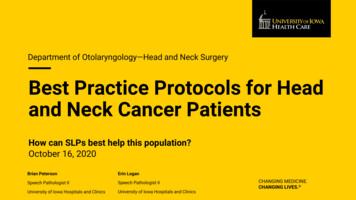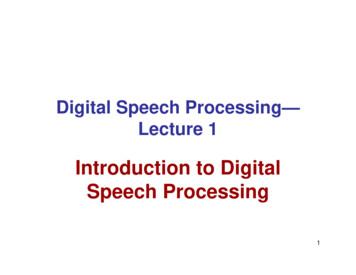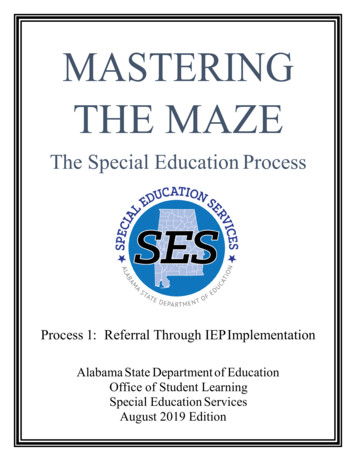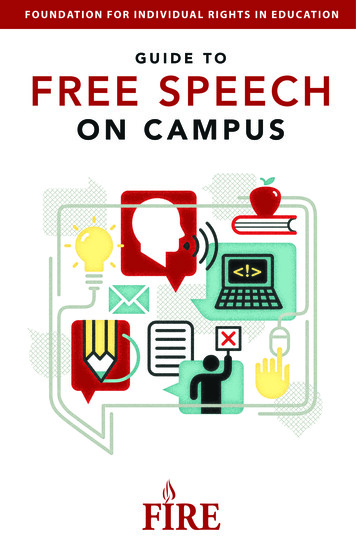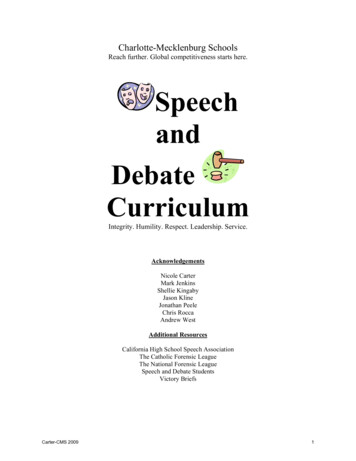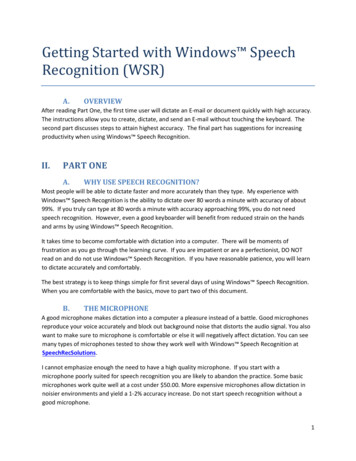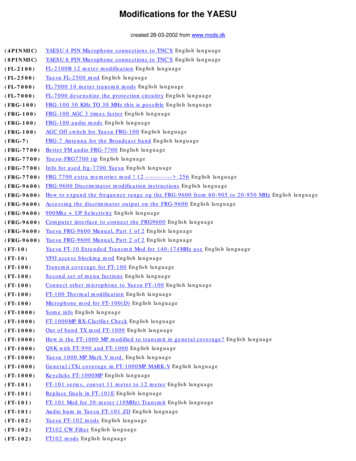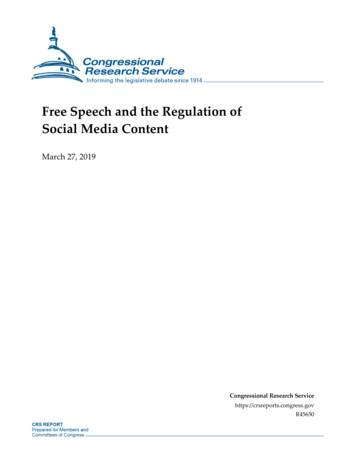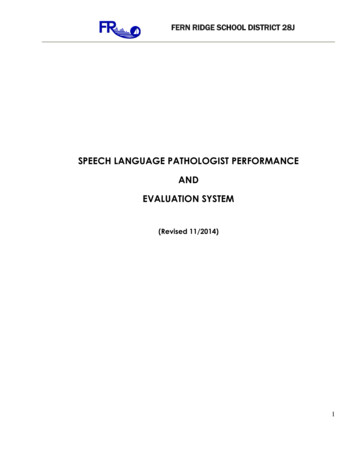
Transcription
FERN RIDGE SCHOOL DISTRICT 28JDisclosure ReleaseSPEECH LANGUAGE PATHOLOGIST PERFORMANCEANDEVALUATION SYSTEM(Revised 11/2014)1
FERN RIDGE SCHOOL DISTRICT 28JDisclosure ReleaseFern Ridge SchoolsSpeech Language Pathologist Performance Review and Evaluation SystemTABLE OF CONTENTSTimeline of Teacher Evaluation and Observations 3Contract Teacher: Performance Evaluation Flowchart .4-5Probationary Teachers: Improvement Cycle Evaluation Flowchart .6Domains: Guiding Questions 7-23Formal Evaluation Form – Fern Ridge Schools Performance Evaluation Rubric . . 24-31Yearly Self-Evaluation Form – Fern Ridge Schools Performance Evaluation Rubric 32-37Goal-Setting Form 38-40Informal Observation Form A 41Informal Observation Form B 42Professional Growth Action Plan .43Professional Growth Action Plan Part 2 .44Glossary of Terms . 45-46Components of the Student Learning and Growth Goal Setting Process – Key Ideas.472
FERN RIDGE SCHOOL DISTRICT 28JDisclosure ReleaseTimeline of Speech Language Pathologist Evaluation and ObservationsThe primary objective of an evaluation system is to improve instruction and to facilitate a positivelearning environment where students experience success, growth, and achievement.Evaluation is a collaborative, continual improvement process based on clear expectations andobjective data, in which competence is verified, strengths are assessed, and excellence isacknowledged. Emphasis of the evaluation system should be professional growth where employees areempowered to be self-directed. Support and assistance are provided for individual teachers needingthe opportunity to remedy specific weaknesses.In addition to utilizing direct classroom observations, an evaluator may use a variety of studentperformance data, collaborative assignments, non-instructional duties, curricular responsibilities, andstudent input when formulating a final evaluation. Student feedback and/or performance data will notbe used independently to formulate teacher evaluation.Probationary Speech Language Pathologist TimelineBy October 15thBy January 1stBy March 1stBy June 1stYearly SelfEvaluation Form(pg. 32-37),Professional GrowthAction Plan (pg. 4243) and GoalSetting Form (pg.38) due tosupervisor.First InformalObservation (pg. 3940) and first FormalEvaluation (pg. 25-31)with discussions.Second InformalObservation (pg. 3940) and secondFormal Evaluation(pg. 25-31) withdiscussions.Yearly ReflectionMeeting with supervisorto go over Yearly SelfEvaluation Form (pg.32-37), ProfessionalGrowth Action Plan (pg.42-43) and Goal-SettingForm (pg. 38).Formal EvaluationForm filed with thedistrict office.Formal EvaluationForm filed with thedistrict office.Contract Speech Language Pathologist TimelineBy October 15thBy January 1stBy April 15thBy June 1stYearly SelfEvaluation Form(pg. 32-37),Professional GrowthAction Plan (pg. 4243) and GoalSetting Form (pg.38) due tosupervisor.Two InformalObservations (pg. 3940) with discussions.Non-Evaluation Year Two InformalObservations (pg. 3940) with discussions.Yearly ReflectionMeeting with supervisorto go over Yearly SelfEvaluation Form (pg.32-37), ProfessionalGrowth Action Plan (pg.42-43) and Goal-SettingForm (pg. 38).Evaluation Year -OneInformal Observations(pg. 39-40) and oneFormal EvaluationForm (pg. 25-31).Formal EvaluationForm filed with thedistrict office everyother year.3
FERN RIDGE SCHOOL DISTRICT 28JDisclosure ReleaseContract Speech Language Pathologist: Performance Evaluation Flowchart (page 1)Completes Yearly Goal-Setting Process by October 15 Speech Language Pathologist completes Goal-Setting Form and Professional GrowthAction Plan Speech Language Pathologist engages in ongoing professional growth activities Formal evaluation every two years.To page 2 Informal ObservationNon-Evaluation Year: Supervisor conducts four (4)Informal Observations with feedback by April 15th.Evaluation Year: Supervisor conducts three (3) InformalObservations with feedback by April 15th.NoYesDo InformalObservationsLead toConcerns?Formal EvaluationSupervisor mustconfer withSuperintendent(biannual)Leads toConcernsConcernsReflection Meeting: By June 1 Review observation data Speech Language Pathologist/Supervisor Review Goals andProfessional Growth ActivitiesGoal-Setting Process: By June 1 Speech Language Pathologist Reflects on Professional Growth Action Plano Goal-Setting, Professional Growth Activities and YearlyEvaluation FormCompleted Yearly Evaluation Forms due to District Office by June 14
FERN RIDGE SCHOOL DISTRICT 28JDisclosure ReleaseContract Speech Language Pathologist: Performance Evaluation Flowchart (page 2)Comprehensive Focused Performance Review Supervisor to meet with the Speech Language Pathologist to reviewPerformance Evaluation Rubric in areas of concern.NoReturn to InformalObservations Longer Observation(s)/Gather Data Within three (3) weeks following prior supervisor/SLP concerns (dateagreed upon by SLP and supervisor). ConcernsSupport Strategy Set specific goals and activities relating to identifiedconcerns (building supervisor and certified employee) Longer informal and formal observation/gather dataSupportstrategysuccessful?YesReturn to InformalObservationsNoImprovement Plan Formal Plan Developed (Building and District LevelAdministration, Teacher and Association) Establish Appropriate DeadlinesImprovementPlansuccessful?YesReturn to InformalObservationsNoNon-Renewal/Non ExtensionRecommendation to School Boardby March 15
FERN RIDGE SCHOOL DISTRICT 28JDisclosure ReleaseProbationary Speech Language Pathologist: Improvement Cycle Evaluation FlowchartStandards Review and Goal-setting: By October 15 Review and explain Performance Evaluation Rubric Review and complete Goal-Setting Form TimelineFirst Set of Observations: By January 1 First Informal Observations completed First Formal EvaluationConcerns Conference and written summary with the review of PerformanceEvaluation Rubric based on observations.Supervisor mustconfer withSuperintendentSecond Set of Observations: By March 1 Second Informal Observations completedConcerns Second Formal Evaluation Conference and written summary with the review of PerformanceEvaluation Rubric based on observations.No ConcernsProbationary Year 2 and 3: By June 1 SLP/Supervisor Review Goals andProfessional Growth ActivitiesSummativeEvaluationMeetingBegin Plan forImprovement onProbationary SLPImprovement Cycle. Establish Professional Growth Activities Move to Yearly Goal-Setting on ContractTeacher Growth CyclePlan of Improvement Plan of Improvement FormImprovementPlanSuccessful? Site-based Plan with District and Association involvement Strategies: 8-12 weeksNoYeso Set Specific goals and activities relating to identified concerns.(Building-level administration and certified employee)o Review of Performance Evaluation Rubric in area of concernNonRenewalReturn toObservation Yearin Growth Cycleo Formal observation(s)/gather datao Conference: Supervisor and Speech Language Pathologist toreview observation data6
FERN RIDGE SCHOOL DISTRICT 28JDisclosure ReleaseFERN RIDGE SCHOOL DISTRICT 28JDomain 1: Identification and Evaluation SLP Standard 1: Referral ProcessGuiding Questions: Is the screening relevant to the needs of the student? Is the referral being conducted in a timely manner? Are the referral results conveyed to the team/teacher?Highly EffectiveSLP is proactive in responding to referralsand completes highly competentscreenings of student needs.EffectiveSLP responds to referrals and completesthorough screenings of student needs.Area for GrowthSLP responds to referrals when pressedand completes adequate screenings ofstudents.Does Not MeetSLP fails to respond to referrals orcompletes hasty screenings of studentneeds.Possible evidence to look for: Procedures for referrals and screening results are clear and communicated to staff and key stakeholders. RTI and EBISS documentation.7
FERN RIDGE SCHOOL DISTRICT 28JDisclosure ReleaseFERN RIDGE SCHOOL DISTRICT 28JDomain 1: Identification and EvaluationSLP Standard 2: AssessmentGuiding Questions: Does the SLP use a variety of testing materials? What kind of assessment data does the SLP use to inform decision making? Does the SLP observe in multiple settings?Highly EffectiveSLP uses and interprets a variety of nondiscriminatory standardized and nonstandardized assessments and observes inmultiple contexts to evaluate students’strengths and needs.EffectiveSLP uses and interprets a variety of nondiscriminatory standardized assessmentsto evaluate students’ strengths andneeds.Area for GrowthSLP uses and interprets limited assessmentsto evaluate students’ strengths andneeds.Does Not MeetSLP administers inappropriate assessmentsto evaluate students’ strengths andneeds. Does not interpret resultsaccurately.Possible evidence to look for: The SLP selects current, culturally sensitive, and evidence-based assessment techniques and tools relevant to the identified referral questions. The SLP obtains information about student’s strengths and needs from a variety of sources. The SLP observes student within multiple contexts of performance. Assessments are performed, scored, and interpreted with accuracy.8
FERN RIDGE SCHOOL DISTRICT 28JDisclosure ReleaseFERN RIDGE SCHOOL DISTRICT 28JDomain 1: Identification and Evaluation: SLP Standard 3: Documentation of EvaluationGuiding Questions: Are the evaluation reports clearly written and understandable? Is the evaluation information presented to key stakeholders in a way that is clear and tied to educational performance? Is the SLP able to answer questions presented by key stakeholders?Highly EffectiveEffectiveArea for GrowthDoes Not MeetEvaluation results are comprehensive, wellwritten, and show a clear understandingof student’s unique needs. Pertinentinformation, including specificrecommendations that are relevant toevaluation findings, is provided to assistwith planning program and determiningeligibility.Evaluation results show a clearunderstanding of student’s unique needs.Pertinent information, including generalrecommendations, is provided to assistwith planning program and determiningeligibility.Evaluation results show adequateunderstanding of student’s needs. Limitedinformation is provided to assist withplanning program and determiningeligibility.Evaluation results show minimalunderstanding of student’s needs.Inadequate information is provided toassist with planning program anddetermining eligibility.Possible evidence to look for: The SLP analyzes and interpret information gained through assessment and state guidelines to determine student eligibilities. The SLP integrates results of assessments and develops recommendations. The SLP provides clear, concise written documentation to include relevant history and overall levels of communicative functioning. The SLPR effectively communicates how disability adversely affects students’ educational performance. Content is clearly written and understandable. District and Federal time requirements are met.9
FERN RIDGE SCHOOL DISTRICT 28JDisclosure ReleaseFERN RIDGE SCHOOL DISTRICT 28JDomain 2: Preparation and PlanningSLP: Standard 4: CommunicationGuiding Questions: Does SLP collaborate with parents, school personnel, and key stakeholders when developing programs and services for student? Does the SLP meet and/or communicate regularly with colleagues regarding students’ needs?Highly EffectiveSLP engages in routine andExemplary communication withparents, school personnel, and keystakeholders. SL0P uses and sharespertinent information to planprograms and services for students.EffectiveSLP engages in routine and effectivecommunication with parents, schoolpersonnel, and key stakeholders. SLPuses pertinent information to planprograms and services for students.Area for GrowthSLP engages in somecommunication with parents, schoolpersonnel, and key stakeholders. SLPuses some information to planprograms and services for students.Does Not MeetSLP rarely engages incommunication with parents, schoolpersonnel, and key stakeholders. SLPrarely uses information to planprograms and services for students.Possible evidence to look for: The SLP is receptive to input from colleagues. The SLP encourages colleagues to share professional ideas, thoughts, and comments regarding students’ educational needs. The SLP maintains documentation of communication with parents, school personnel, and key stakeholders.Domain 2: Preparation and PlanningSLP Standard 5: Goal DevelopmentGuiding Questions: Is the SLP familiar with the Oregon Common core State Standards and how they influence speech-language goal development? Is the speech-language IEP goal(s) clear and measureable and based on current and relevant data?Highly EffectiveSLP develops clear and measureablegoals based on a variety of assessmentresults and input from the IEP team thatare aligned with developmental normsand Oregon Common Core StateStandards.EffectiveSLp develops measureable goals basedon assessment results that are alignedwith developmental norms and OregonCommon Core State Standards.Area for GrowthSLP rarely develops measurable goals.Developed goals are based on limitedinformation and are sometimes alignedwith developmental norms and OregonCommon Core State Standards.Does Not MeetSLP develops non-measurable goals thatare not aligned with developmentalnorms and Oregon Common Core StateStandads.Possible evidence to look for: The SLP is familiar with students’ IEP goals and they are readily available. The SLP draws from Common Core State Standards when writing IEP goals. The SLP uses a variety of formal and informal assessment results when developing goals.10
FERN RIDGE SCHOOL DISTRICT 28JDisclosure ReleaseFERN RIDGE SCHOOL DISTRICT 28JDomain 2: Preparation and PlanningSLP Standard 6: MaterialsGuiding Questions: Does the SLP use a variety of materials to meet the needs of the students? Does the SLP connect materials to the learning objectives of the session? Does the SLP use developmentally appropriate materials?Highly EffectiveEffectiveArea for GrowthDoes Not MeetSLP selects, organizes, creates andadapts innovative and developmentallyappropriate materials for the students’individual communicationgoal(s)/need(s). SLP shares materials withcolleagues.SLP selects, organizes, and adaptsrelevant and developmentallyappropriate materials for the students’individual communicationgoal(s)/need(s).SLP selects materials that are somewhatrelevant and developmentallyappropriate for the students’ individualcommunication goal(s)/need(s).SLP uses limited materials that are notconnected or relevant to the students’individual communicationgoal(s)/need(s).Possible evidence to look for: The SLP selects/develops unique materials to meet their students’ needs. The SLP adapts/uses classroom curriculum. The SLP shares materials with colleagues. The SLP is able to modify materials during therapy sessions, as needed.11
FERN RIDGE SCHOOL DISTRICT 28JDisclosure ReleaseFERN RIDGE SCHOOL DISTRICT 28JDomain 3: Delivery of ServiceSLP Standard 7: InterventionGuiding Questions: Does the SLP implement evidence-based interventions when supporting student goals and objectives? Does the SLP use a variety of tools and strategies to engage and motivate students? Does the SLP provide timely feedback/reinforcement?Highly EffectiveSLP systematically implements evidencebased interventions to fostercommunicative competence andprovides consistent feedback andreinforcement to students.EffectiveSLP implements evidence-basedinterventions and provides somefeedback and reinforcement tostudents.Area for GrowthSLP occasionally implements evidencebased interventions and providesinconsistent feedback andreinforcement to students.Does Not MeetSLP rarely implements evidence-basedinterventions and does not providefeedback and reinforcement tostudents.Possible evidence to look for: The SLP can describe best practices when it comes to instruction and research. The SLP promotes generalization of therapeutic interventions. The SLP implements the service delivery model most appropriate to the student’s communication challenges and needs. The SLP expresses feedback clearly and respectfully. The therapy activities are appropriate for the student’s age, grade, and cognitive level as well as interest and aptitudes.12
FERN RIDGE SCHOOL DISTRICT 28JDisclosure ReleaseFERN RIDGE SCHOOL DISTRICT 28JDomain 3: Delivery of ServiceSLP Standard 8: Knowledge of Student NeedGuiding Questions: Does the SLP understand the educational needs of his/her student? Is the SLP familiar with the students’ IEP goals? Does the SLP collaborate with school personnel to determine student needs and how to address them?Highly EffectiveSLP displays robust understanding of howdisabilities impact students’ attitudes,behaviors and performances. Utilizes thisknowledge to create meaningful andrealistic opportunities and to differentiateinstruction.EffectiveSLP displays solid understanding of howdisabilities impact students’ attitudes,behaviors and educationalperformances. Utilizes this knowledge todifferentiate instruction.Area for GrowthSLP displays general understanding ofhow disabilities impact students’attitudes, behaviors and educationalperformances. Occasionally utilizes thisknowledge to differentiate instruction.Does Not MeetSLP displays minimal understanding ofhow disabilities impact students’attitudes, behaviors and educationalperformances. Does not differentiateinstruction.Possible evidence to look for: The SLP orchestrates Exemplary strategies, materials, and groupings to involve and motivate students. Students are actively engaged in learning. The SLP capitalizes on teachable moments. The SLP is effectively able to communicate learning goals and objectives to students. The planned instruction is relevant to student learning styles and needs and to cultural differences.13
FERN RIDGE SCHOOL DISTRICT 28JDisclosure ReleaseFERN RIDGE SCHOOL DISTRICT 28JDomain 3: Delivery of ServicesSLP Standard 9: Flexibility/ResponsivenessGuiding Questions: Does the SLP modify therapeutic instruction based on data gathered during therapy? Does the SLP use a variety of scaffolding techniques? Does the SLP use frequent assessment techniques to monitor and adjust their instruction in a timely manner?Highly EffectiveSLP is continually seeking ways toimprove treatment and makes changesas appropriate in response to student,parent, and/or teacher input.EffectiveSLP makes revisions in treatment whenconfronted with evidence of the needfor change.Area for GrowthSLP considers changes in treatmentwhen confronted with evidence of theneed for change.Does Not MeetSLP adhere to the plan or program inspite of evidence of its inadequacy.Possible evidence to look for: Students are actively engaged in learning. Students understand and learn what is delivered. A variety of formative and summative assessments are in use. The SLP capitalizes on teachable moments. The SLP helps colleagues adapt and differentiate instruction for students.14
FERN RIDGE SCHOOL DISTRICT 28JDisclosure ReleaseFERN RIDGE SCHOOL DISTRICT 28JDomain 3: Delivery of ServicesSLP Standard 10: Student InteractionsGuiding Questions: Do students feel safe, respected and valued? How does the SLP respond to students’ treatment of each other in the therapy environment? Does the SLP make connections with students?Highly EffectiveEffectiveArea for GrowthDoes Not MeetSLP shows warmth, caring, respect, andfairness for all students and builds strongrelationships. Earns students’ respect andcreates a climate in which disruption oflearning is extremely rare and handledpromptly and effectively.SLP is fair and respectful toward studentsand builds positive relationships. Builds aculture of respect within the learningenvironment.SLP is fair and respectful toward moststudents and builds positive relationshipswith some. Wins the respect of somestudents but there are regular disruptionsin the learning environment.SLP is sometimes unfair and disrespectfulto the group; plays favorites. Is notrespected by students and the learningenvironment is frequently chaotic.Possible evidence to look for: The SLP communicates with students in a respectful and positive manner in all situations. The SLP models effective communication, empathy and respect. The SLP’s non-verbal cues match what he/she is assaying to the student. The SLP is poised and dynamic and promptly addresses virtually all discipline problems. Students are respectfully engaged in learning and activities?15
FERN RIDGE SCHOOL DISTRICT 28JDisclosure ReleaseFERN RIDGE SCHOOL DISTRICT 28JDomain 3: Delivery of ServicesSLP Standard 11: ReflectionGuiding Questions: Does the SLP take time to reflect on a lesson? Does the SLP modify therapy based upon reflective analysis?Highly EffectiveSLP’s reflection is highly accurate andperceptive, citing specific examples thatwere not fully successful for at least somestudents. SLP draws on an extensiverepertoire including input fromcolleagues to identify alternativestrategies.EffectiveSLP’s reflection provides an accurateand objective description of practice,citing specific positive and negativecharacteristics. SLP makes some specificsuggestions as to how the therapyprogram might be improved.Area for GrowthSLP’s reflection on practice is moderatelyaccurate and objective without citingspecific examples, and with only globalsuggestions as to how it might beimproved.Does Not MeetSLP does not reflect on practice, or thereflections are inaccurate or self-serving.Possible evidence to look for: When appropriate, SLP utilizes student feedback. The SLP is constantly pursuing professional growth opportunities and applies what he/she learns. The SLP can describe best practices when it comes to instruction and research. The SLP reviews speech, language, and hearing literature and makes use of new information during therapy. The SLP works with colleagues to reflect on what worked and what didn’t and continuously improves instruction.16
FERN RIDGE SCHOOL DISTRICT 28JDisclosure ReleaseFERN RIDGE SCHOOL DISTRICT 28JDomain 4: ManagementSLP Standard 12: Service DeliveryGuiding Questions: Does the SLP maximize the use of time and resources? Is the SLP able to effectively schedule within the educational setting? Does the SLP meet the SDI time as designated on IEP for students on their caseload?Highly EffectiveSLP uses a variety of creative strategiesthat provide efficient service deliverymodels to meet student needs.EffectiveSLP uses a variety of strategies thatprovide efficient service delivery modelsto meet student needs.Area for GrowthSLP uses limited service delivery modelsto meet student needs.Does Not MeetSLP does not vary service delivery modelto meet student needs.Possible evidence to look for: The SLP collaborates with teachers and staff to determine what is best for students. The SLP applies creative strategies within the framework of the educational setting.17
FERN RIDGE SCHOOL DISTRICT 28JDisclosure ReleaseFERN RIDGE SCHOOL DISTRICT 28JDomain 4: ManagementSLP Standard 13: CaseloadGuiding Questions: Does the SLP serve students regularly and consistently? Does the SLP participate in intervention team meetings? Is the SLP able to manage a diverse caseload?Highly EffectiveSLP continually makes decisions oneligibility, including dismissal. Providesprompt and consistent intervention tospecial education students. Supportsgeneral education initiatives that focuson achievement for all students.EffectiveSLP continually makes decisions oneligibility while serving a variety of specialeducation students withspeech/language services on their IEP.Area for GrowthSLP maintains caseload while limitingservice delivery to only students whohave a Communication Disordereligibility.Does Not MeetSLP inefficiently manages caseload andinconsistently serves students.Possible evidence to look for: The SLP continually evaluates caseload. The SLP collaborates with staff to determine needs across educational settings. The SLP serves on teams that promote the use of data-driven instruction, evidence-based practices and the use of problem solving models.18
FERN RIDGE SCHOOL DISTRICT 28JDisclosure ReleaseFERN RIDGE SCHOOL DISTRICT 28JDomain 5: Professional ResponsibilitiesSLPC Standard 14: ProfessionalismGuiding Questions: Does the SLP respond professionally to all constituents: parents, students, colleagues, supervisors and the community? What kind of recordkeeping and documentation system does the SLP use to keep track of communication with all stakeholders? How effectiveis that system? Does the SLP reliably perform required duties as assigned?Highly EffectiveSLP presents self as a consummateprofessional and always observesappropriate boundaries.EffectiveSLP demonstrates professionaldemeanor/behavior and maintainsappropriate boundaries.Area for GrowthSLP occasionally acts and/or present selfin an unprofessional manner anddisrespects boundaries.Does Not MeetSLP frequently acts and/or presents self inan unprofessional manner and violatesboundaries.Possible evidence to look for: The SLP communicates in a professional, respectful and positive manner to district/building personnel. The SLP’s recordkeeping system is clear, organized, up-to-date, and easy to understand. The SLP can be counted on to complete all required duties, reports and paperwork in a timely manner (e.g., attendance, email, etc.). The SLP resolves concerns and problems in an appropriate and timely manner. Professionalism may include regular attendance and punctuality, appropriateness of dress, ethical and honest judgment, respect of boundariesand confidentiality, and among other qualities applicable to the position and school expectations.19
FERN RIDGE SCHOOL DISTRICT 28JDisclosure ReleaseFERN RIDGE SCHOOL DISTRICT 28JDomain 5: Professional ResponsibilitiesSLP Standard 15: CollaborationGuiding Questions: During the evaluation and IEP process, is the SLP involved with colleagues? To what extent is SLP involved with collaboration? Does the SLP have respectful relationship with colleagues?Highly EffectiveCollaborates with classroom teachers,other professionals, and peers whensharing ideas, looking at student work,and utilizing data to drive instruction.EffectiveCollaborates with classroom teachers,other professionals, and peers to sharetherapy ideas while looking at studentwork.Area for GrowthMeets infrequently with classroomteachers, other professionals, to sharetherapy ideas.Does Not MeetDoes not meet with classroom teachers,other professionals, and peers and is notopen to collaboration.Possible evidence to look for: The SLP highly values collaboration and positive relationships. The SLP meets frequently with collaboration teams, such as PLCs, SET, and/or EBISS. The SLP is receptive to input from colleagues, outside agencies, and other stakeholders to provide a system of support that enhances thestudent(S) learning experiences. The SLP encourages colleagues to share professional ideas, thoughts, and comments regarding learning? The SLP shares information, ideas, materials and resources with peers and others.20
FERN RIDGE SCHOOL DISTRICT 28JDisclosure ReleaseFERN RIDGE SCHOOL DISTRICT 28JDomain 5: Professional ResponsibilitiesSLP Standard 16: Self-ImprovementGuiding Questions: Is the SLP a self-directed learner when it comes to professional growth opportunities? Does the SLP seek involvement in activities that will further his/her professional growth and promote student learning? Does the SLP earn continuing education or professional development units to meet requirements for the Oregon Board of Examiners’ licensingrequirements?Highly EffectiveSLP seeks out best practices, feedback,and suggestions, which are integratedinto practice. Active participant ofprofessional workshops, study groups,reading and/or research to improvespeech-language learning.EffectiveSLP listens thoughtfully to otherviewpoints and responds constructivelyto suggestions and criticism. Seeks outeffective therapy ideas from colleaguesand other sources.Area for GrowthSLP keeps an eye out for new ideas toimprove therapy, but implementation iswith mixed results. Shows minimal interestin listening to feedback and suggestions.Does Not MeetSLP is not open to ideas for improvingtherapy and learning. Is defensiveand/or resistant to changing professionalpractices.Possible evidence to look for: The SLP can describe best practices when it comes to instruction, content area, and research. The SLP is constantly seeking to improve his/her performance through professional growth opportunities as a life-long learner by reviewingliterature and sharing with others. The SLP is involved in professional activities that address possible areas for growth. The SLP presents to his/her peers.21
FERN RIDGE SCHOOL DISTRICT 28JDisclosure ReleaseFERN RIDGE SCHOOL DISTRICT 28JDomain 5: Professional ResponsibilitiesSLP Standard 17: Rules, Regulations, Laws, and Ethical StandardsGuiding Questions: Does the SLP hold or is working towards an Oregon Board of Examiners for Speech Language Pathology License? Does the SLP adhere to federal and local policies and procedures? Does the SLP consult with colleagues/administrators regarding ethical/legal issues?Highly EffectiveSLP demonstrates professionalperformance and consults withcolleagues regarding ethical and/orlitigious situations while upholding theethical behavior and rules andregulations as outlines in the OregonBoard of Examiners for SpeechLanguage Pathology.EffectiveSLP upholds the importance of ethicalb
Completes Yearly Goal-Setting Process by October 15 Speech Language Pathologist completes Goal-Setting Form and Professional Growth Action Plan Speech Language Pathologist engages in ongoing professional growth activities Formal evaluation every two years. Informal Observation Non-Evaluation Year: Supervisor conducts four (4)
